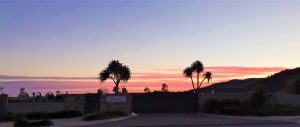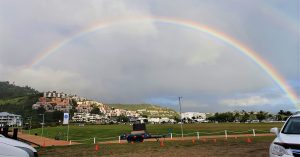June 2021 Whitsunday Conservation Council Inc
In this Edition
 The Whitsunday Conservation Council is celebrating a milestone. We have been incorporated for a little over a year but have already gained over 1,000 members and supporters. Many more have used our submission services to get messages through to the Whitsunday Regional Council.
The Whitsunday Conservation Council is celebrating a milestone. We have been incorporated for a little over a year but have already gained over 1,000 members and supporters. Many more have used our submission services to get messages through to the Whitsunday Regional Council.
We are a group of people concerned about our environment – its future and in all its forms – from the reef on our doorstep to the unique tropical rainforests and endangered flora and fauna.
 Our umbrella group gives people in our region a voice over issues from tree clearing and soil run off to the environmental impact of high rise, rubbish, the way we treat dugongs and turtles – and much more.
Our umbrella group gives people in our region a voice over issues from tree clearing and soil run off to the environmental impact of high rise, rubbish, the way we treat dugongs and turtles – and much more.
Our aim is to help through awareness and remediation, involving all levels of government.
We are all volunteers but we rely upon your support. Thank you from us all.
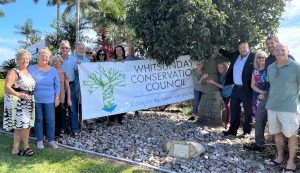 Last year WCC noticed that Whitsunday Regional Council (WRC) was planting Whitsunday Bottle Trees around our locale. The WCC logo is a stylised bottle tree so we were very pleased to see this but were concerned that the trees uniqueness had no acknowledgment. We needed our community & visitors to understand that this Whitsundays species is found only within 40kms of Airlie Beach & no-where else in the world. It is listed as ‘rare’ under the Nature Conservation (Wildlife) Regulation 1994.
Last year WCC noticed that Whitsunday Regional Council (WRC) was planting Whitsunday Bottle Trees around our locale. The WCC logo is a stylised bottle tree so we were very pleased to see this but were concerned that the trees uniqueness had no acknowledgment. We needed our community & visitors to understand that this Whitsundays species is found only within 40kms of Airlie Beach & no-where else in the world. It is listed as ‘rare’ under the Nature Conservation (Wildlife) Regulation 1994.
So after a WCC request to council, WRC Mayor Andrew Willcox, Parks & Gardens Manager Mark Callaghan and WCC members gathered at 11am on June 3rd to mark the installation of a descriptive plaque at the “Hugging Tree”, adjacent to the “Welcome to Airlie” sign overlooking our beautiful Whitsunday waters. This particularly attractive mature tree was supplied by nursery owner Irene Bailey, who also gave the tree its very apt nickname, “because its shape just invites hugs”.
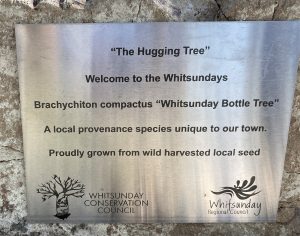 But unfortunately, the tree is coming under increasing pressure from development.
But unfortunately, the tree is coming under increasing pressure from development.
In response, council has currently surveyed the distribution and abundance of the Whitsunday Bottle Tree to better manage the development on sites where the tree occurs.
Would you like your own Whitsunday Bottle Tree?
Whitsunday Catchment Landcare volunteers propagate the tree from locally collected seed at the Bushcare nursery. This centre is supported by WRC. Seedlings are available for sale from Landcare & from WCC at our monthly market stall. Butterfly Effect Nursery has mature trees for sale.
ADDITIONAL INFORMATION:
Brachychiton compactus grows in vine thickets on foot hills and coastal areas. Unfortunately, it is coming under increasing pressure from development. Whitsunday Regional Council has currently surveyed the distribution and abundance of the Whitsunday Bottle Tree to better manage the development on sites where the tree occurs.
The name compactus refers to its smaller form compared to the other bottle trees and the seed pod is smaller compared to Flame Trees and Bottle trees in general. The leaves are palmate (5-lobed) when young but become simple (non-lobed) as the tree matures. The flowers are white with pink spots and are followed by boat shaped pods that contain up to ten peanut sized seeds covered in irritating hairs.
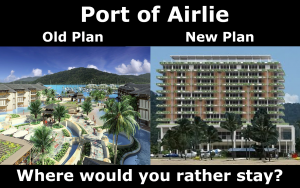 Despite overwhelming community feedback against high-rise when our town plan was written in 2016, Council left an open invitation for developers to make applications to any heights in Airlie Beach precincts. This has resulted in Port of Airlie applying for 47 metres where 18 metres is considered the ‘code’ height in our plan.
Despite overwhelming community feedback against high-rise when our town plan was written in 2016, Council left an open invitation for developers to make applications to any heights in Airlie Beach precincts. This has resulted in Port of Airlie applying for 47 metres where 18 metres is considered the ‘code’ height in our plan.
Such a construction near our foreshore would forever change the skyline, views, character and amenity of our town and it would probably be only the first of many to take us away from our successful model of low to medium-rise buildings conforming to our natural landscape flowing from the beach up into the hills.
WCC group members Fight for Airlie and Save Our Foreshore have rallied the community to voice their concerns. On June 7, 1193 submissions were delivered to the Council. This was preceded by 842 online submissions. That’s 2035 submissions saying NO to high rise in Airlie Beach. Listen up Council!
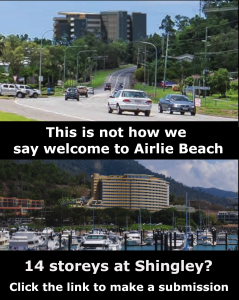 While public consultation has closed on Port of Airlie and it is now up to the Council to assess and decide, another application for 14 stories near Shingley Beach is still open for public input. You can have your say in a submission to Council here: www.whitsundayconservation.org.au/shingley-beach-high-rise
While public consultation has closed on Port of Airlie and it is now up to the Council to assess and decide, another application for 14 stories near Shingley Beach is still open for public input. You can have your say in a submission to Council here: www.whitsundayconservation.org.au/shingley-beach-high-rise
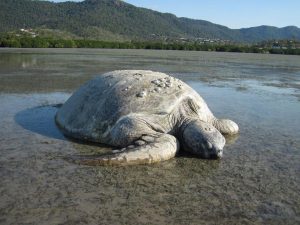 Here in the Whitsundays, we are lucky to have species such as sea turtles and dugongs right on our doorstep. Many people don’t realise that literally right off the boardwalk or beach at Cannonvale, there is a large seagrass meadow where Dugongs and Green Turtles graze at high tide, and turtles bask on the mud at low tide. Both species feed almost exclusively on seagrass, with an adult dugong consuming up to 40 Kgs per day, while an adult Green Turtle can crop up to 2 Kgs of leaves each day.
Here in the Whitsundays, we are lucky to have species such as sea turtles and dugongs right on our doorstep. Many people don’t realise that literally right off the boardwalk or beach at Cannonvale, there is a large seagrass meadow where Dugongs and Green Turtles graze at high tide, and turtles bask on the mud at low tide. Both species feed almost exclusively on seagrass, with an adult dugong consuming up to 40 Kgs per day, while an adult Green Turtle can crop up to 2 Kgs of leaves each day.
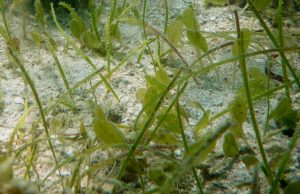 Luckily tropical seagrasses are amongst the most productive habitats known, with an entire meadow able to replace all of its leaves in just 10 days. The Pigeon Island seagrass meadow is a significant food resource for dugongs and turtles, as well as a nursery for fish, crabs and prawns and a feeding are for migratory wading birds in summer. Seabed with seagrass is home to 40 times more creatures than bare sediment, which provides food for our inshore marine life.
Luckily tropical seagrasses are amongst the most productive habitats known, with an entire meadow able to replace all of its leaves in just 10 days. The Pigeon Island seagrass meadow is a significant food resource for dugongs and turtles, as well as a nursery for fish, crabs and prawns and a feeding are for migratory wading birds in summer. Seabed with seagrass is home to 40 times more creatures than bare sediment, which provides food for our inshore marine life.
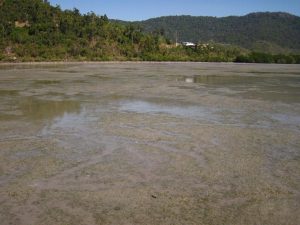
Stretching from VMR, right across to Botanica on the other side of the bay, the meadow is about 946 Ha in area. The seagrass species found there are species which dugongs and turtles prefer; this is not just a happy coincidence! Dugongs have been compared to farmers, in that their feeding habits (a little like a snow-plough going through), and consequent defecation, actually encourages the germination and growth of the exact species that they prefer to eat.
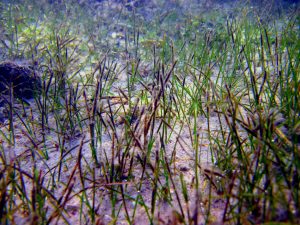 Seagrass needs sunlight to grow, so with the bay often being quite murky, it is mostly restricted to growing in the shallow intertidal area. This means that dugongs and turtles are feeding in the shallows there every high tide. As the numbers of boats on the local waterways keep increasing, these animals are at increased risk of boat strike, or being driven off their feeding grounds by the frequency of small boats and jet-skis travelling at speed over the meadow at high tide. Local commercial jet-ski tour operators are aware of the presence of wildlife and avoid travelling at high speed over the meadow. Private owners of boats/jet-skis may not even be locals and seem to be unaware of the risk of hitting wildlife as there are no signs to warn them of this precious feeding ground. They even seem to be unaware of how shallow the area is: one jet-ski ran completely aground on the seagrass right next to Pigeon Island recently.
Seagrass needs sunlight to grow, so with the bay often being quite murky, it is mostly restricted to growing in the shallow intertidal area. This means that dugongs and turtles are feeding in the shallows there every high tide. As the numbers of boats on the local waterways keep increasing, these animals are at increased risk of boat strike, or being driven off their feeding grounds by the frequency of small boats and jet-skis travelling at speed over the meadow at high tide. Local commercial jet-ski tour operators are aware of the presence of wildlife and avoid travelling at high speed over the meadow. Private owners of boats/jet-skis may not even be locals and seem to be unaware of the risk of hitting wildlife as there are no signs to warn them of this precious feeding ground. They even seem to be unaware of how shallow the area is: one jet-ski ran completely aground on the seagrass right next to Pigeon Island recently.
Whitsunday Conservation Council has taken up this issue, which has been raised with authorities on many occasions by a number of people over the years, so far to no avail. We argue that if a 6 knot zone can be implemented for the safety of people on boats in the mooring grid, then a go-slow zone can be implemented to protect dugong and turtles on the seagrass meadow. An example exists already where this had been done in Moreton Bay Marine Park:
And we need signs to alert people to our special feeding ground.
Hopefully with enough support we can get some public education and a Go-Slow zone so that we can keep enjoying the privilege of having these amazing wildlife right by where we live.
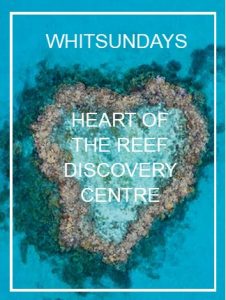 What makes us different here in the Whitsundays – in terms of coral?
What makes us different here in the Whitsundays – in terms of coral?
Fringing reefs. We have 74 or up to 90 islands (depending on which figures you care to use). Fringing reefs grow close to the shore as opposed to the outer reefs which are offshore. They protect shorelines from damage as well as provide vital habitats such as seagrass beds, mangrove and saltmarsh vital for the survival of our marine creatures: three species of turtles; tropical rock lobsters and protected fish species as well as giant clams.
While many tourists flock to our region to go out on a boat to see these reefs and wonder at the fairyland below, how much do they know about the reef in which they are snorkelling?
The Whitsunday Conservation Council (WCC) came up with the idea of a Reef Discovery Centre, a state-of-the-art interpretation centre for the Great Barrier Reef, housed here in the Whitsundays. The Heart of the Reef Discovery Centre seemed to be the most apt name as the Whitsundays is also home to the magnificently beautiful Heart Reef – coral that has naturally formed into a heart shape found in Hardy Reef – discovered in 1975 – and only able to be visited by air.
While there has been much discussion for such a centre over the years across various government and tourism plans, we hope to make this happen.
It would be a state-of-the art facility providing digital and real exhibits including aquariums drawing on all of the science and research conducted on our Great Barrier Reef from GBRMPA to AIMS and university research. It would inspire, educate and showcase our natural wonders acting as a giant storyboard with interactive experiences for students of all ages to better understand the largest living organism to be seen from outer space.
It would include cultural topics such as the region’s First Nation history featuring the seafaring Ngaro Traditional Owners. It would show off our environmental achievements: Turtle Rescue’s Eco Barge and the Whitsunday Climate Change Innovation Hub and profile all the hard work from our volunteers involved in activities such as seagrass planting and marine debris collection. It would include an overview of our underwater sculpture trail and, most importantly, catapult our region into a growing eco and edutourism space.
The Centre would also serve as a citizen science hub, co-ordinating volunteer activities to help our Great Barrier Reef with coral monitoring and seeding where visitors can become actively involved in conserving the reef for future generations. Visitors would also have the opportunity to learn about how to tackle issues such as water quality and climate change to help the reef survive.
Such a facility does not exist anywhere else in Queensland, the state with more than eight million hectares of marine park, fish habitat areas encompassing world-class national and conservation parks, marine reserves and no less than five World Heritage areas.
It will put us on the map not just for our beautiful fringing reefs and turquoise waters and iconic Whitehaven Beach but to inspire everyone to help conserve our magnificent reef, one of the seven natural wonders of the world.
So far WCC has made presentations to both the Cannonvale State School and the Whitsunday Christian College; Whitsunday Regional Council (including Mayor Andrew Willcox and Olivia Brodhurst, Climate Change Innovation Hub Coordinator at the WRC); State MP, Amanda Camm, Coral Sea Marina; Tourism Whitsundays and the Whitsunday Charter Boat Association.
The proposal has met with resounding enthusiasm as a mainland alternative for tourists to our region as well as contributing to a much needed educational boost to attract tertiary, primary and secondary students to our region.
It will also provide the opportunities to build strong partnerships between our local government and the state and federal governments in a positive way.
If you would like to get involved; have a presentation delivered or to hear more about the project. Specifically, if you have architectural or artist’s skills (we are aiming at an artist’s impression of the Centre) or economic development skills, we’d love to hear from you. We are also looking for volunteers to help spread the word at our regular market stall.
Please contact: admin@whitsundayconservation.org.au
